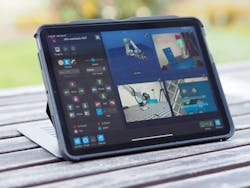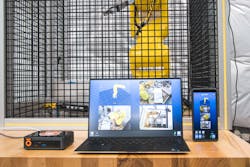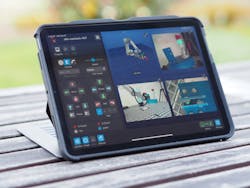Industrial Robots: Remote Monitoring and Control Solution Boosts Productivity
It’s a scenario many integrators are all too familiar with: A robot has failed in the middle of production, bringing an entire line to a halt. Every hour of downtime costs the client tens of thousands of dollars. You’ve been on several calls already, but you need to get onsite and the earliest you can make it is tomorrow morning. The fix itself—updating a waypoint—takes less than 10 min. The production manager is delighted that production is up and running again, but in the time it has taken to get onsite, the facility is down hundreds of thousands of dollars.
This scenario is frustrating and time-consuming for integrators. It’s also enough to put some companies off deploying automation altogether. This is particularly true for many small-to-medium size (SME) companies where budgets can’t justify the ongoing maintenance costs of automation deployments. There has to be a better way to handle robot errors remotely.
The Pandemic Effect
COVID highlighted the effectiveness of remote robot monitoring and control technology—and the limitations of some systems. The trend towards increased adoption of remote robot monitoring and control systems was already happening pre-pandemic, but spurred by social distancing requirements and driven by labor shortages, industry adopted the technology at an unprecedented rate.
As a result, over the past few years the benefits of remote monitoring and control software have become apparent: Companies can restart production faster, gain access to robotics experts more quickly and reduce troubleshooting costs. The global market for remote monitoring and control systems was estimated at U.S. $23 billion in 2020. It’s no surprise then, that by 2026, it’s expected to reach $31.7 billion at a CAGR of 5.4%.
However, not all remote monitoring and control systems are the same. Some provide monitoring only, which send out alerts but don’t get integrators any closer than that to solving the problem. Most provide a layer of analytics capabilities that allow companies to tweak their automation for better performance, using KPIs such as overall equipment effectiveness.
READ MORE: Barely There: Replacing Manual Operations with Lights-out Processes
A Fresh Approach
Industry is familiar with setups in which a computer takes remote control of industrial robots. This technology is mature and well understood. However, industry is not so used to humans stepping in and taking remote control of industrial robots—let alone remote error recovery.
The main reasons for this are cultural challenges around robot safety and cybersecurity. But what if those challenges have been solved? The recent emergence of a new human-centered remote monitoring and control system for industrial robots provides a new take on remote connectivity and control.
Consisting of several USB or IP cameras, a compute box and software, the plug-and-play system provides 24/7 low latency video and data access to any robot cell. Once secure remote access has been configured, integrators can monitor and manage automation remotely from anywhere via any browser-capable device. When an error occurs with a robot, the system sends out an alert via that secure connection, completely avoiding the cloud—and a host of cybersecurity risks—in the process.
Uniquely, it also allows humans to safely control the robot from any location via a secure browser connection and without violating the robot’s existing safety permissions and restrictions. This means that velocity, acceleration and joint limit settings on the robot are always obeyed when remote controlling the arm.
READ MORE: The Benefits of Wirelessly Monitoring Tank Levels
Integrator Dividends
Manufacturers appreciate the reduced error recovery times and improved analytics. But integrators, as the industry segment that will bring this technology to the wider world, are also set to gain massively from the new generation of remote monitoring and control systems.
The biggest challenge facing integrators is time management, according to Blake Krieger, a robotic systems engineer at Minnesota-based automation integration specialists Infinity Robotics LLC and an early adopter of the new technology.
“Demand for automation is rising all the time,” said Krieger. “We have plenty of opportunities for new projects, proposals and concepts. However, we also have existing projects on the floor that need to be delivered and supported. The latest remote monitoring and control system multiplies our productivity and frees up time to take on new customers. We installed the technology just a few weeks ago and it has already saved us three on-site service calls.”
Integrators are spread thin, especially with global demand for automation on the rise. By slashing the length of time it takes to solve robot errors, the latest remote robot control technology enables integration firms to support additional customers without making any sacrifices in terms of quality.
READ MORE: Full Automation: The Path to Lights-Out Production
Multiplying Productivity
The new technology is set to be a “game-changer” for integrators, said Brad Sparkman, president and CEO of Innovative Finishing Solutions (IFS), a leading integrator of FANUC paint robots for the automotive industry, and another early adopter of the technology.
“We fully expect this technology to become standard on both new and legacy industrial robot deployments in a short period of time,” said Sparkman. “In our case alone, for example, we have deployed thousands of robots. Given the current labor challenges and rising demand for automation, we expect a majority of those to be retrofitted with the new system within the next couple of years.”
For companies like IFS, the latest remote robot control technology enables their automation experts to serve more customers without having to leave the office. It also allows engineers to handle more troubleshooting calls each day.
“It’s one thing to receive an alert when a robot has malfunctioned. It’s quite another to be able to do something about it, such as remotely jog a gripper to release a part. This new remote robot control solution saves companies many hours of agonizing downtime, giving them reassurance that their automation investment is being maintained effectively,” Sparkman said.
Eyes on the Ground
Even when customers are fully trained on a robot or cobot system, they still need a lot of support, said Karl Ericsson, CEO of SE Automation, a leading system integrator based in Stockholm, Sweden and an early adopter of the new technology. “Before the new technology came along, we had to support customers via telephone, WhatsApp and videoconferencing,” Ericsson said. “Now, with remote monitoring and error recovery, we can actually ‘be’ there, see the pendant as well as the whole cell, and get production up and running again. It enables us to do more with less staff.”
SE Automation quotes for the system as part of every new automation deployment and has plans to upgrade legacy installations with the technology. Said Ericsson: “It doesn’t matter whether you deploy the system on the latest cobot or a 30-year-old painting robot. It doesn’t matter whether your production run is high mix/low volume or vice-versa. It doesn’t even really matter whether you’re at the office or in an airport lounge. The latest remote monitoring and control system gives you the visual and telemetry data integrators need to solve problems faster than ever before.”
This article was submitted by Ryan Cox, VP of Engineering at Olis Robotics.



